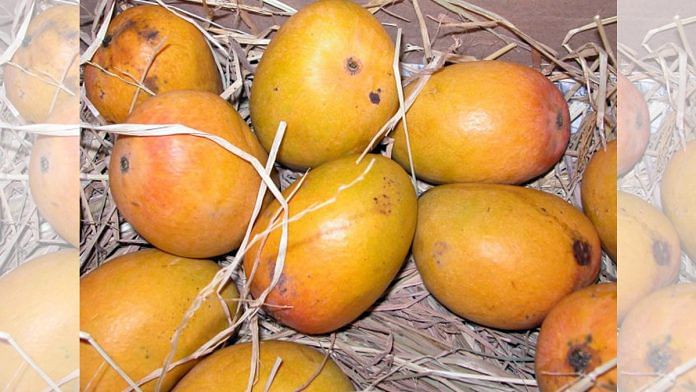New Delhi: Cyclone Tauktae battered the country’s west coast states of Gujarat and Maharashtra last month. Now, the damage caused by the storm has brought an early end to the premium mango season in these states.
Heavy wind and rainfall amid the cyclone destroyed mango orchards across the two states, causing fruits to fall prematurely. This blow to the output in these states — which lead in the production of India’s export varieties — could lead to a substantial dip in mango exports from the country.
While the cyclonic heavy winds ruined the popular Alphonso variety grown along the Konkan coast areas of Maharashtra such as Ratnagiri and Sindhudurg, it also damaged another exotic mango variety in Gujarat’s Saurashtra region — Kesar.
Mostly, the produce has been hit in the Gujarat districts of Junagadh, Amreli, and Gir Somnath, where Tauktae made landfall. But the Maharashtra districts of Ratnagiri, Sindhudurg, Raigad, Mumbai, Thane and Palghar have also been affected significantly.
According to traders, the cyclone’s estimated impact on mango sales is upwards of Rs 500 crore. This comes in addition to the losses due to the demand plunge due to the Covid-19 lockdown.
Also read: Forecast of another normal monsoon expected to boost planting of major crops
Quantity down, quality hit too
“The cyclone hit right in the middle of the peak season of Kesar mango, which goes on from 1 April to 20 June. But this year it will get over in the next 5-7 days as most of the mangoes in major growing areas have fallen from the trees due to strong winds of a cyclone,” said Adreman Panja, a wholesale mango trader and exporter in the fruit market of Junagadh.
“The daily arrival in Junagadh mandi has dipped from the usual 30,000-40,000 boxes of mangoes per day to 8,000-10,000 boxes per day now,” he added.
One box contains 10 kg of mangoes. The per-box rate has dropped from the usual Rs 700-900 to Rs 300-500 now, said Panja, adding that this “used to be the rate of mangoes in mid-June after a couple of rains”.
Even the mangoes that are arriving in the market are of poor quality, with the farmers trying to sell them as soon as possible to prevent further deterioration.
According to traders, the worst affected mango farms in Gujarat are in Rajula, Jafarabad, Una, Gir-Gadhada, Talala, and Kodinar among other coastal areas of Saurashtra.
The Alphonso farms in Konkan have also been damaged. The farmers in these areas were already hit by a drop in production because of climatic conditions, a slowing market, and export decline amid the pandemic.
“The cyclone has hit us when the last spell of Alphonso harvest was going on. Hundreds of trees have been uprooted, which has led to tonnes of fruits ready to be harvested for the market being destroyed,” said Jitu Seth, a mango orchard owner in Ratnagiri.
Also read: Why the Indian economy won’t get a V-shaped recovery this time
Cyclone impact comes over and above Covid hit
The cyclone damage has proved to be a double whammy for farmers in India’s western region, which were already reeling under losses caused by a demand drop and export restrictions due to Covid.
Mansukh Patoliya, who owns a mango orchard spread over 40 acres in Alavani, Gir Somnath district, said the cyclone has brought a premature end to mango exports this season. He isn’t able to sell his produce at a better price in the domestic market either due to quality issues.
“I had 600 mango trees in the orchard ready for harvest but after the cyclone barely 200 trees worth of mangoes are left. Those too have been damaged by winds and rain, hence will not fetch us good prices domestically, let alone export level prices,” he said.
“We are looking at a loss of at least Rs 25 lakh this season just from the cyclone alone, without counting the Covid damage in sales,” added Patoliya. According to him, the price of Rs 300-500 per box doesn’t even cover the cost of the cardboard box used to pack mangoes.
According to Vidyadhar Joshi, Konkan Alphonso Mango Producers and Sellers’ Association, the cyclone has caused an estimated loss of Rs 500-700 crore over and above the losses of Rs 19,000-20,000 crore due to lockdown demand and export-related hit this year.
He added that last year the national lockdown had resulted in losses estimated at around Rs 15,000 crore.
“A lot of farmers will be on the road after this season. We were already under heavy loans to recover from last year’s lockdown losses. Even the tourism and fishing business has been wiped out by cyclones and lockdowns,” said Seth.
The export hit
The Kesar mangoes form around 25 per cent of India’s mango export basket. So, the damage caused by Cyclone Tauktae is likely to cause a substantial dip in the country’s mango exports.
While the prized Alphonso from the Konkan areas of Maharashtra is majorly exported to the Middle East, the Kesar mangoes, owing to their longer shelf life, are exported to much farther destinations such as the US and European countries.
“While the loss estimate for mango farmers across the state is yet to be accomplished, it may be more than half of the usual amount this year as the season has ended earlier,” said a state horticulture department official in Gujarat who didn’t wish to be named.
“The farmers were already suffering from damage in the flowering season of mangoes on trees last year due to unseasonal rain. The cyclone has further caused either complete loss of the fruit or rendered remaining mangoes unsuitable for the export markets,” the official added.
Initial inputs suggest the Kesar export from Gujarat is expected to dip by at least 5,700 metric tonnes, leading to a loss of Rs 390-500 crore, the official added.
Also read: How govt prevented a farming crisis by increasing DAP fertiliser subsidy as global prices soar



